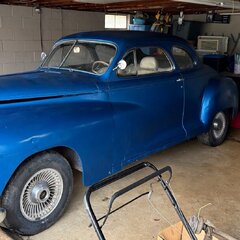My 48 is set up the same way. 1st pull parking lights, 2nd pull the front parking lights go out and the head lights come on. When I wired in the turn signals, the signals work with the headlights on. I believe this is the case for most cars from back then. The parking lights were the notice the car but not for the driver to see anything. The headlights were to let the driver see in the dark and the parking lights did not add to the area of effect to see surrounding details.
Also to note, by not using the front parking lights with the headlights it lessened the strain on the generator by about 2-3 amps. Each incandecent bub draws about 1 to 1.5 amps. It may be more as the 6v systems are 1/2 the volts twice the amps of a 12v system. (I believe) The gennys had to spool up to about 1500 engine RPMs to reach full output. So at low speed/idle your lights drained the battery. Hence the lights brighten when you revved the engine. With the advent of alternators (set output at low speed) when the engine is at idle, you still get full power, so no need to manage your electrical systems.
Joe Lee


